Megamobilisation vs. hapless net-zero hopium
author Cimino
work-in-progress published 20240312
added to menu 20240403

Negative-Carbon Liquid-Fueled Five-Stroke v 9 Staff Car Painted Black : As a vehicle to unabashedly demonstrate Climate Polycrisis-megamobilisation leadership—liveried in iridescent tūī black—a ch2o2specifically, formic acid-powered tourer would surely be a mega-attention-grabber. Pictured here, though, is the necessarily desert-drab rhd Humberright-hand-drive, being British, Humber, but not a Humber Super Snipe, despite sharing some Super Snipe parts Heavy Utility 4 wd in which John Poston drove Winston Churchill when the latter inspected units of the New Zealand Division with, clockwise, Bernard Freyberg and Bernard Montgomery. The megalomaniacal staff car envisioned would seat nine and sport running boards for Africato use a prone-to-be-perceived-as-insensitive New Zealand colloquialism for: of generous quantity, originally in the context of Horn of Africa famine relief public subscription.
photographer Harold Paton
Warning to the blithefully unafflicted This 3000-word-and-half-as-many-again-in-footnotes article will be appreciated only by those suffering from severe climateor more specifically: climate/zero-carbon energy cognitive-dissonance. The article’s brutal premise is that:
- Megamobilisation is beyond-urgent
- even with megamobilisation, a point-of-no-return may be exceeded
- irrespective of 2. , the point-of-no-return has very possiblygiven global inertia and the magnitude of the megamobilisation called for already been exceeded
- megamobilisation may yet save billions from annihilation
- megamobilisation, for most of humanity, will be vastly more richly rewarding—and, for the terminally curious, hugely more exciting—than haplessnot to mention, tedious and mutually suicidal net-zero hopium.
The very rich may be able toor, will continue to, as the case may be fortify and insulate themselves, but only the determinedly disanthropicmassively misanthropic, doesn’t seem adequate will actually enjoy living in a world that fails to Climate Polycrisis-megamobilise. Moreover, no trillionaire will get escape to a less hostile planet.
Readers of its unedifying history will scarcely credit that the Climate Polycrisis took so long to be convincingly named. Successive cohorts of historians will struggle to explain this phenomenon, and labour to quantify quite how critical a lacuna it was in impeding anything remotely approaching a timely, proportionate, practicable response.

Proto-Megamobilisation Heroes: The proto-megamobilisation, within the world of immunology, that produced the raft of effective vaccines in totally unprecedented time is the definitive demonstration of what is possible when the mission is placed squarely ahead of the selfish interests of the market. Incomprehensibly, and not auguring well for Climate Polycrisis-megamobilisation anytime soon, is the absence of any agreement on a global pandemic accord by who member states. Pictured, covid-19 pandemic heroes Corbett, Graham, Kariko, and Weissman.
image Time magazine
In hindsight, climate change, as a long-used blanket term for civilisation’s first literallyas horrific as global nuclear war would have been, or might yet be, it would likely not have rendered, or render, Earth uninhabitable. The same cannot begin to be said for passing a climatic point-of-no-return existential crisis is going to appear curiouslynot to mention unperturbed, entirely combobulated, and inexplicably unconcerned detachednot to mention unperturbed, entirely combobulated, and inexplicably unconcerned. Despairing of getting through to its readership, the Guardian, five years ago, resorted to using global heating. By itself, however, the term doesn’t begin to do the work of climate polycrisis, in conveying the complexity and magnitude of the all-encompassing challenge.
Arguably, though, the even tougher question for historians will be why the mobilisation mountedpresumably it was eventually mounted, for Pete’s sake in response to the Climate Polycrisis, took so long to be unambiguously named. Unequivocally naming the global response was always going to be the more necessary imperative than collectively naming the swarm of interconnected contributing crises. Climate emergency, meantime, appears doomed to be recorded as the alarm the world determinedly wouldn’t hear—either that, or the alarm the world took the battery out of. For fear of ridicule, a civilisation of eight billion collectively behaves as if there’s no reason to be alarmed:
Things’ll sort themselves out; always do!
Predicting the future is a fool’s preoccupation. Planning a better—or at the very least, survivable—future, in contrast, and mobilising to achieve it, is the toil of heroes. But planning can also be a foolish pursuit, particularly if undertaken by the energy illiterate. The tragictempted to say hilarious, but appeal of alliteration, on this occasion, must yield to good taste irony of the once-hallowed school-strikes for climate is that school students desperately need to learn about energy—precious few people, whether school or tertiary educated, are energy-literateand actual literacy, not rote renewables ideology. This baked-in shortcoming is permitting half-baked climate–energy literacy to pass for the real thing. Small wonder, for example, that 45% of New Zealanders polled placed recycling within the top three climate actions, instead of relegating it commensurate with its Radio New Zealand: In reality, recycling is the sixtieth most effective measure to cut your emissions, said Ipsos New Zealand managing director Carin Hancock.reportedly 60th-as-effective-as-living-private-light-vehicle-free importance. Putting one billionpredominantly private, 1.31 billion in 2020 light vehicle fleet, projected to be 2.21 billion by 2050 – International Energy Outlook 2021 battery-powered cars, utilities, and other private-light-vehicles on the road is not going to prevent civilisation and the biosphere passing the point of no return—the exact opposite, in fact.
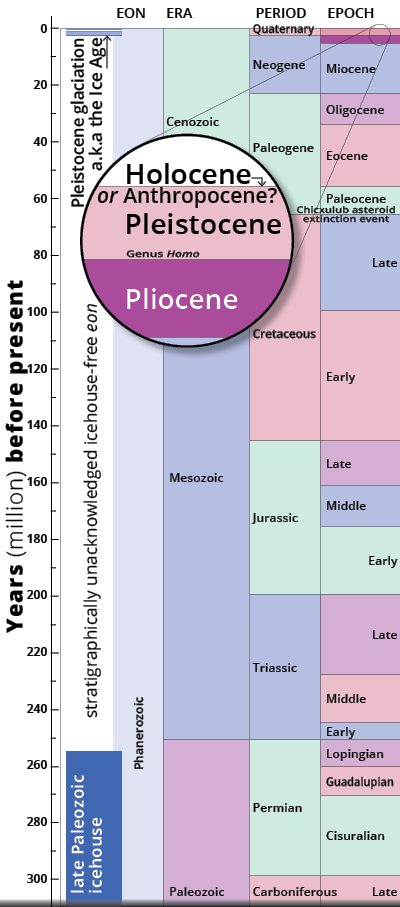
Mega-Stratigraphical Fail: Proposition that a 20th century-centric epoch be created was always going to be a struggle for Planet Earth’s stratigraphers, not least of all because of the likely too hasty 1885 declaration of the Holocene Epoch. Regardless of how anthropogenic global heating plays out, the big geological picture—totally missed by the International Union of Geological Sciences—is likely to record the beginning of the Holocene as the anthropogenically-assisted planetary end of the ice houses/ages. A very big geological deal indeed, befitting the naming of an eon, much less an era, period, or mere epoch.
chart Mahurangi Magazine
Meantime, respondents in the market-Ipsos Group SA (société anonyme)research-Ipsos Group SA (société anonyme)companyIpsos Group SA (société anonyme) survey quoted above were asked about the greenhouse-gas-emissions-reduction-impact of not having pets, but were not asked about the impact of not having children, or further children. To quote Reproduction and the Carbon Legacies of Individuals :
Under current conditions in the United States, for example, each child adds about 9 441 metric tons of carbon dioxide to the carbon legacy of an average female, which is 5.7 times her lifetime emissions. A person’s reproductive choices must be considered along with theiras published: his, highlighting the knots writers unnecessarily tie themselves in to avoid using the always perfectly serviceable “their”. In this instance, of course, both female and male involved share the carbon-legacy responsibility day-to-day activities when assessing theiras published: his, highlighting the knots writers unnecessarily tie themselves in to avoid using the always perfectly serviceable “their”. In this instance, of course, both female and male involved share the carbon-legacy responsibility ultimate impact on the global environment.
Leading a breeding-moratorium movement, however, is neither for the faint-hearted, nor for pale-male boomers. If it gets to be led by any demographic, it will be because it was led by the fecund and fabulously communicationally gifted. Only history will record whether young heroes achieved what the grownups failed to, with a Market Economy-challenging ending of growth-for-growth’s-sake economics, and launching of the megamobilisation, and thus the mega-climate-mobilisation economy .
A proportionate response was always going to be well beyond what even myriad market-adjustments could conceivably have ever achieved. Prior to the 1970s and the all-confounding ideology of neoliberalism, suggesting that a sufficiently deregulated market economy could consign the need for any and all state planning and control to history, would have been dismissed as utterly asinine. Given the enormity of the task of globally replacing fossil fuels that are the source of 80% of energy used, mobilisation, never mind a few regulations, was always going to be necessary. Now, with billions of lives on the line, anything short of megamobilisation is unconscionable—and very probability futile, to boot.
Proximate responsibility for the paucity of energy literacy could, arguably, be sheeted home to the dismal pseudo-science of economics. The larger question, however, is why energy, as a distinct discipline of science, hasn’t seen a century of Nobel Energy Prizes awarded. Energy essentially underpins civilisation, with fossil fuel underpinning all Vaclav Smil’s “four pillars of modern civilisation” : ammonia, cement, plastics, and steel. Civilisation is currently desperately dependent upon ammonia. Without the 150 million tonnes produced annually, or the 80% of it which is used to produce fertiliser, billions would abruptly perish.
What is unknown, and is currently unknowable, is whether an immediate, near-total moratorium on fossil-fuel use will be sufficient to prevent passing the global-heating point of no return. One very large ship, the Earth Icehouse , has almost certainly already sailed. It matters a lot because the benign icehouse-interglacial in which civilisation evolved, is precipitously barrelling towards a polar-icesheet-and-glacier-free, Greenhouse Earth. Anthrozoic Greenhouse Earth, Homo sapiens sapiensas opposed to Homo sapiens, to acknowledge Homo sapiens idaltu, and to avoid the more cumbersome alternative of ‘anatomically modern human being’, and for sheer cussedness could get used to. However, how many humans and their fellow species survive the anthropogenic-global-heating bottleneck to enjoy Anthrozoic Greenhouse Earth, is the $100-trillion-a-yearcurrent annual global economy question.
More immediately, given how long it will take to turn the fossil-fuelled behemoth around, all talk of there being a budget within which nations can safely stay without catastrophic consequences is speculative in the extreme. Because there are yawning gaps in the science, it behoves humankind to mobilise immediately to address the Climate Polycrisis. If it transpires that global-warming-in-the-pipeline greatly exceeds ipcc modelling, as the world’s most eminent climate scientists have been serially warning, humankind will have reasons aplenty to be grateful that business-as-usual was the path not taken. Nor, of course, is there much that is usual about the uncurbed kleptocratic feudalism that has buried anything resembling ethical business behaviour—a corporate world where nothing but greed-on-steroids is saluted. Any expectation that the fate of civilisation and the biosphere can be entrusted to some benign, fantastical, invisible hand of the market is delusional.
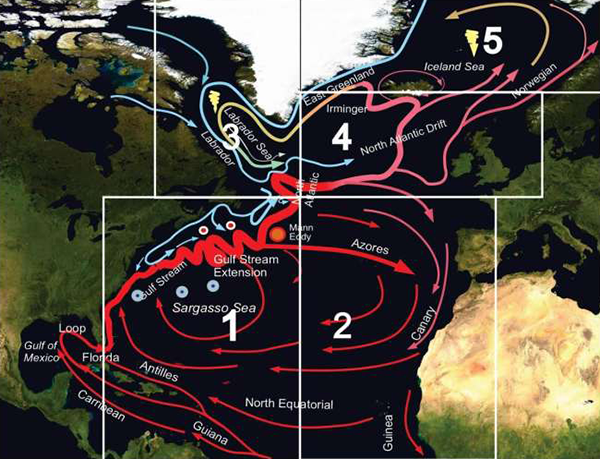
No Longer the Day After Tomorrow: Although it was always going to unfold in a manner more nuanced than Hollywood was capable of depicting, the slowdown of the Atlantic Meridional Overturning Circulation, now a well-documented fact, was always just a few hapless net-zero-hopium decades away. On its own, the slow-down and impending collapse of the 1000-year-per-rotation global thermohaline “conveyor” was more than ample call for the Climate Polycrisis-megamobilisation. Even more remarkable is that sea-level rise and the prospect of life without sandy beaches doesn’t already have the world’s billion coastal-city dwellers tearing up the cobblestones and baying for action from their elected representatives.
scheme Frontiers in Marine Science
Time, meantime, has run out. On 7 March 2024, the formerly steadfastly upbeat British environmentalist-son-of-New Zealand’s-first-Aotearoa-born-governor-general said:
The science-based institutions on which we depend to address this crisis have comprehensively failed us. The Intergovernmental Panel on Climate Change is incapable of telling the whole truth about accelerating climate change; the Conference of the Parties (under the un Framework Convention on Climate Change) has been co-opted by the fossil fuel lobby to the point of total corruption. By not calling out these incontrovertible realities, mainstream scientists are at risk of becoming the new climate deniers.
Sir Jonathon Porritt’s website promptly exceeded its permitted bandwidth and became unresponsive, hopefully for a no-more-sinister reason than his Mainstream Climate Science: The New Denialism? article was swiftly shared so widely. Those reading Porritt’s 2020 Hope in Hell – A Decade to Confront the Climate Emergency , meantime, will marvel—or, despair—at his abrupt change of tune, a mere four years into said decade. The reluctant realisation that global heating cannot be kept under a destabilising 1.5°, a ruinous 2°, nor likely a billions-dooming 2.5°, is an unparallelledly appalling appreciation:
And there goes my reputation as a “glass half-full sort of a guy”! I will, from herein ondeft deployment of “from here on in”?, be badged as a full-on “doomist”, a “prophet of apocalyptic despair”, an anarchist /communist /subversive seeking “to bring down capitalism” by “existentializing” (I kid you not!) the “perfectly manageable threat of climate change”.

Meanwhile Back in the Cretaceous Period: The story of the last continent to form, and to drown, the most recent habitable landmass to form, the last to be discovered by Homo sapiens sapiensas opposed to Homo sapiens, to acknowledge Homo sapiens idaltu, and to avoid the more cumbersome alternative of ‘anatomically modern human being’, and for sheer cussedness, and the last to
be colonisedreluctantly, in respect to Whitehall, provides a rich source of origin stories to ground the proximately existential one, of the Climate Polycrisis-megamobilisation.
rendering ManuMata
Any person who still considers, or otherwise purports, the anthropogenically-enhanced greenhouse effect to be a “perfectly manageable threat” is either misinformed, disinformed, deeply disingenuous, or profoundly disinterested. The latter condition can, of course, be excused in the chronically downtrodden, disadvantaged, and otherwise disheartened.
Coincidentally, three weeks after layperson Porritt’s mea culpa, climate scientists James Hansen, Makiko Sato, and Pushker Kharecha published a paper titled Global Warming Acceleration: Hope vs Hopium , pleading:
Accelerated global warming is the first significant change of global warming rate since 1970. It is important because it confirms the futility of “net zero” hopium that serves as present energy policy and because we are running short of time to avoid passing the point of no return .
In the cause of mobilisation, storytelling is clearly indispensable, beginning with a transfixing storyteller—a latter-day Churchill or jfk, or ClooneAmal or Georgey-Damon-DiCapriopreferably whichever can be persuaded to move on from his crypto infatuation-or-Pitt. Key to convincing a stellar storyteller to go all in, however, would be a sufficiently powerful story, and the more unexpected the better. The dearth of compelling solutions—as opposed to the if-that’s-your-solution-I’m-not-convinced-we’ve-got-a-problem, variety—is the singular impediment. Solutions, to be synonymous with megamobilisation, must be mega-solutions. If the storytelling was Aotearoa-centric, the standout contender is Dr Earl Bardsley’s heroic Lake Onslow pumped-storage hydroelectricity scheme. Predictably rubbished by self-interested power utilities and neoliberals alike, New Zealand’s notionally National-led government has summarily cancelled the country’s most promising energy infrastructure project in half a century, despite the strenuous efforts of the Parliamentary Commissioner for the Environment. This, without a murmur of rebuke from either the Labour or the Green party.
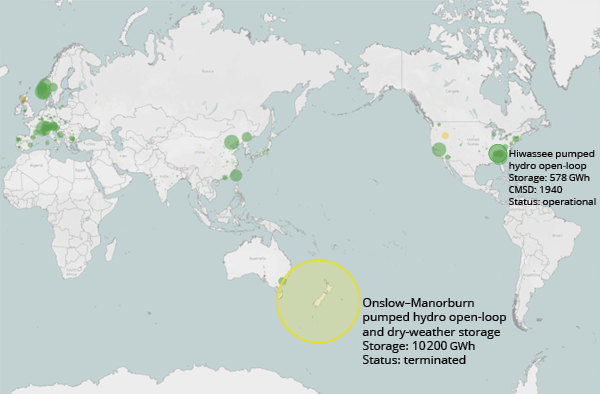
So Much for Putting Aotearoa Front and Centre on the Pumped Hydro Storage Map: By shamefully dragging its feet on pumped-storage hydroelectricity, the Labour Party’s best shot at energy redemption—by committing to the world’s largest pumped storage scheme—was squandered. In retrospect, the writing was on the dam wall when lithium-ion partisans were pandered to by the project being styled as a batterythe NZ Battery Project—it was always vastly more than that. Circle representation here is proportionate to Snowy 2.0’s pink circle—Snowy 2.0 291 gwh; Lake Onslow 5500 gwh.
map International Hydropower Association |
onslow representation Mahurangi Magazine
While there are various chicken-and-egg scenarios in which the megamobilisation might be plausibly initiated, the least likely—judging by its serial failure—is the ipcc’s fundamentally flawed, you-first-no-you-first, intergovernmental approach. A much stronger case can be made for a single, small country—by convincingly demonstrating meaningful mobilisation—being the more probable gamechanger. New Zealand’s prime minister Jacinda Ardern proved—until soon dragged down by the inertia of her own party, and by her natural enemies—that decisive and compassionate leadership can capture world headlines. What was lacking, to back up the decisiveness and compassion, was the mobilisation. Infrastructure, for example, at-scale filtered-air quarantine/care accommodation—had it been promptly modular-manufactured and deployed—would have gone on to serve Auckland’s droves of rsv-vulnerable young, and flu-vulnerable elderly, winter after winter. Similarly, air filters failed to be fitted to busesand trains too, of course, but twice as many people use buses: https://www.stats.govt.nz/news/car-streets-ahead-for-travel-to-work-and-education/ to address the prevailing very poor ventilation, unimproved despite the enduring covid pandemic, and its long debilitating manifestations.
Capturing the world’s imagination, however, will take mobilisation measures far more alluring than filtered-air urban transport. Aotearoa has twin, signal, carbon-zero challenges: Crossing Cook Strait and the Tasman Sea. While a Picton–Wellinton tunnel would only be a tad longer than the Seikanwhich is 53.85 kilometres (23.3 kilometres undersea). Picton–Wellinton would be about the same length as the combined proposed Channel Islands–mainland France tunnels Tunnelwhich is 53.85 kilometres (23.3 kilometres undersea). Picton–Wellinton would be about the same length as the combined proposed Channel Islands–mainland France tunnels, a zero-carbon surface crossing would be far more salubrious, and psychologically less taxing for passengers than running an undersea gauntlet through three known active geological fault lines.

The Five-Laning Te Tai Tokeraute reo Māori for Northland, New Zealand Actually Needs: Purporting to be resilience project, the Warkworth–Whangārei four-laning announced by New Zealand’s prime minister on 14 April 2024 epitomises the private-light-vehicle-first paucity of solutions of today’s cohort of energy-ignorant politicians. In sublime contrast, the rail-with -trail solution rendered here would electrify—figuratively and literally—every aspect of Northland’s society and economy, not least of all the domestic and Australian visitor industry.
rendering Craig Thorpe
Passenger ferries are inherently problematic, particularly the private-light-vehicle-prioritising roll-on-roll-off variety that predominate on Cook Strait and interisland crossings worldwide. It is instructive that concerted attempts have been made to bypass Tory Channel and Queen Charlotte Soundofficial name—and appalling compromise: Queen Charlotte Sound / Tōtaranui. The opportunity that megamobilisation provides is to totally rethink the Cook Strait ferry experience. The southward journey should begin at Wellington Station, the entrance of which is a mere 150 metres from the water. Whisked down the harbour and across Cook Strait and into the impossibly scenic Marlborough Sounds by the world’s smoothest and fastest ferry, sat near or next to generous, sparkling-clean windows, in business-class comfort, the trip would be sublime—in stark contrast to the horrors passengers are subjected to, transported by the present undersized, underpowered, and patently unfit-for-purpose, second-hand, second-rate fleet.
Length is all important, beginning with the desirability of affording a full two-thirds of passengers a window seat, and legroom. A sufficiently long, maximally wave-piercing hull form, fully stabilised would provide the ultimate in passenger comfort, at a speed that left passengers with little fear that tedium or misery was about set in. To be permitted to travel faster than the current 18-knot limit calls for an ultra-low-drag hull form, and air lubrication, and stabilised to the nth degree—by fin and by gyro. While dyed-in-the-wool catamaran adherents will likely disparage the notion of a small-waterplane-area-monohull—particularly for a stretch of water as notorious as Cook Strait—if perfected, the resultant sea-kindly ride would be the sublime antithesis of that for which the crossing has long been infamous.

Stone’s Throw from Wellington Harbour: Henning Larsen’s inspired addition to Prague Central Station could serve as a challenge to New Zealand’s architects and timber engineers, to masterfully span the 150-metre space between Wellington Station and Harbour, and an all-new, passenger-only, smooth-as-silk Cook Strait ferry service. Proximate project driver is a long-promised new tram line, expected to double station visitors. In-motion-charging trolleybuses, rather than trams—where the tracks had long-since been ripped up—would likely have left sufficient funds to pay for the Prague Central Station extension!
image Henning Larsen Architects
A fundamental need for Aotearoa is for residents and visitors to be able to travel the length of the motute reo Māori: island, or, as in this case, islands, the phlegmatic North Island and South Island, or more colourfully, Te Ika a Maui and Te Wai Pounamu, respectively, fossil-fuel-free. Powering high-speed passenger ferries is no job for batteries. Interisland ferries and intercity buses are far better powered by energy-dense liquid fuel—formic acid, from co2, for example—combusted in today’s superbly efficient fuel-injection, spark-ignition engines, not to mention tantalisingly promising 5-strokes, provided that the liquid fuel is not liquid fossil-fuel.
Crossing the Tasman Sea fossil-fuel-free, in comparison, will be entirely practicable, once the first snr-powered ships begin sliding down South Korean slipways; similarly, reviving coastal shipping. That, and rebuilding and end-to-end electrifying New Zealand’s main trunk lines, were always going to be amongst the megamobilisation big-ticket items. But, once achieved, every Australian within walkingwithin reason, of course distancewithin reason, of course of their prodigious 33 000-km railway system, can be invited to visit, fossil-fuel-free.
With travel reinvented, suitably zero-carbon and civilised, the stage would be set to convince the world, beginning with Australia, that megamobilisation transforms economies and societies into purposeful powerhouses. Aotearoa, on its own, couldn’t hope to convince the world’s large economies, that mobilisation works. Nor could practicable megamobilisation be demonstrated by such a small country, only tease out its potential. In contrast, Australia could convincingly demonstrate, for example, zero-carbon steel production, at scale. It’s the obvious answer to Australia’s iron-ore glut—Australia having recently found its relatively low-grade ore, shipped unrefined in bulk, is to push low-grade iron ore uphill. Meantime, building thorium-powered swashsmall waterplane area single hull passenger and mercantile ships, at its state-owned asc shipyard would be a far more constructive, peace-building mission than adding to the world’s second-strike over-kill fleet of 45 ballistic-missile-launching submarines—plus however many Israeli off what was the Palestinian Coast, targeting Iran.

Biggest Breakthrough Since Screw Propeller Replaced the Paddlewheel: Eversince the incontrovertible need for everything that can practicably be electrified, to be electrified, the maritime world has needed to move beyond John Ericsson’s supremely ingenious screw propeller. Particularly relevant to passenger ferries, not only are abs’s cycloidal propulsors significantly more fuel efficient, they build in the capabilitywith the appropriate number deployed and positioned for a vessel to quickly and safely dock in strong winds, without the aid of tugs.
rendering Asea Brown Boveri
While it is true that anthropogenic global heating is rendering the seas stormier, it is also exacerbating clear-air turbulence. With no probability of thorium-powered airliners ever rolling off the booming Airbus or bombing Boeing final assembly lines, the future of long-distance travel, indubitably, is by rail and by sea. Tragically, trillions are set to be lavished on ensuring the wealthy continue to fly, green-washed-hydrogen and guilt-free.
Crushingly, though, the gulf between measures such as zero-carbon transport, and those certain to be needed to avert wholesale privation and starvation, is immense. Fortunately for both Aotearoa and Australia, the obvious megamobilisation measures will immediately be perceived as unmistakably significant. Foremost imperative is to build high-cube-40-foot-shipping-container-sized accommodation modules, of planted-forest-engineered-timber, on a mega-industrial scale. Already, the global housing shortage demands a billion such modules, to house the 1.6 billion people—and set to at least double by the end of this decade—without. These modules need to be ready for shipping 10 000 at a time, by the time the first fast-tracked thorium-powered mega-container ship docks down-under. The mission—calling for more than 100 000 such voyages of mercy—dwarfs that performed by the 2 7102751 planned, 2710 built World War ii Liberty ships built.
anzac-spirit, and tribute to the heroes of the Manhattan Project and the 2021 covid-19 vaccine breakthrough. Mega-mobilisation, by any other name. Now, about that name …
Megamobilisation vs. hapless net-zero hopium footnotes
Return to article
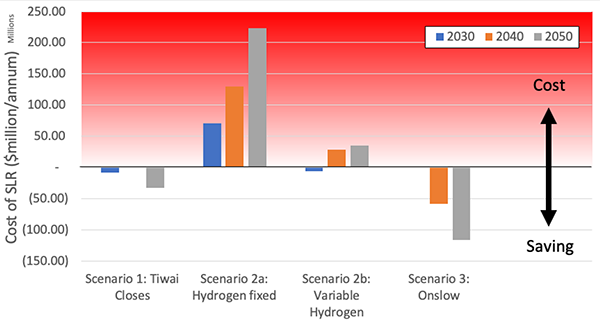
It’s Complicated: Like almost everything about replacing fossil fuels, the detail behind why a $5 billion pumped hydro storage emerges streets ahead of the likes of “green” hydrogen is complicated. The act–National–nz First coalition has terminated-with-malice Dr Earl Bardsley’s heroically visionary Lake Onslow pumped-storage hydroelectric scheme, rather than put in the work to explain why an adult exploration of it was more than warranted. Saving an average of $380 millionby 2050 per year over the greater revenue-earning hydrogen option, merits at least a modicum of consideration. In the current populist political climate, Pathway 2b., where export of the hydro-produced hydrogen would be curtailed to keep electricity prices for consumers reasonable, is not something New Zealanders are likely to see.
image Energy Link
Climate Polycrisis – polycrisis to end all polycrises To presume to improve upon plain Polycrisis as the most useful name to describe the 20th century civilisational and biospherical juncture is to challenge no less a formidable thinker than economic historian Dr Adam Tooze. The Mahurangi Magazine ’s justification for this preposterousness is three-fold. Firstly, anthropogenic global heating trumps all other crises with its incontrovertibly unique combination of irreversibility and extinction-multiplying consequence. Secondly, climate-action mobilisation is beyond urgent—climate-action mobilisation must be optimised in every action designed to address the contemporary polycrisis. Thirdly—purely semantically—there have been numerous polycrises; there will be only one, planetary, Climate Polycrisis.
To date, the received social-psychology wisdom has lectured the imperative to not alarm the audience, lest it be stampeded past collective action into collective despair. By that measure, Winston Churchill, today, would be being browbeaten to avoid all references to the war, much less, fighting GermansWe will fight them in the hills. in the hills. Fortunately for humanity, Churchill wasn’t claiming that the Britain wouldn’t be overrun, but stating she would never surrender, and unambiguously backing that up with massive military and industrialfamously, with the help of Beaverbrook mobilisation.
Return to footnote list

City-Scale Megamobilisation: Criticised as cognitive-dissonance-causing it may be, but master-planned city Rawabi deserves credit as a glowing demonstration of how a vibrant Palestine could credibly grow out of the ashes of intolerance. Today’s world—poised on, or even tipped beyond—the point-of-Climate Polycrisis-no-return, desperately needs grand designs—mega-amphitheatre and all—on the scale of those of damned-if-he-does developer, Palestinian Bashar Masri, and then some.
image Treleaven–Levin
Global government is great Sitting at the intergovernmental level is the inherently undemocratic, un-self-critical un. The famous dysfunction is, of course, at United Nations Security Council level—that, and its membership left open to blatantly, seriallycovert and overt war-makingcovert and overt United States and Soviet Union:
Membership in the United Nations is open to all other peace-loving states which accept the obligations contained in the present Charter and, in the judgment of the Organization, are able and willing to carry out these obligations.
Setting aside the travesty of those arch Cold War adversaries ever being permitted permanent Security Council seats, Russia was allowed to inherit the former Soviet seat unopposed, leading Volodymyr Zelenskyy to subsequently reasonably demand:
Where is this security that the Security Council needs to guarantee?
That the world needed democratic global government should never have been in any doubt. It is both pathetic and forlorn that a 200-year American cleavage to New World Order conspiracy theories—weaponised via the World Wide Web—can poison any prospect of a civilised discourse about how, today, global democracy can be achieved. Meanwhile, the modern God-is-great and maga twin menaces are testimony to the depths of global democratic dysfunction. While waiting for God, instead, for example, of navel-gazing the future of work, megamobilisation must be the work, and the economy.
Return to footnote list
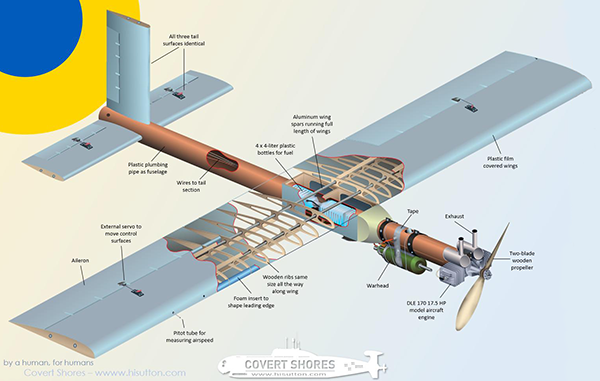
Rendering Epitome of Global Dysfunction: Had fellow Europeans immediately mobilised to stand shoulder to shoulder with their Ukrainian cousins, Putin would have been faced with murdering tens of millions, or withdrawing. Being left to fight for her freedom with home-built, 150 mm-cable-duct fuselaged drones graphically illustrates Ukraine’s plight, and courage. Climate megamobilisation would bind rather than divide countries, and undermine the world’s serially murderous kleptocrats.
rendering Covert Shores
Hopium wars In the preceding, the Mahurangi Magazine argues that megamobilisation is the best antidote for the net-zero hopium that so concerns Hansen et al. In the absence of megamobilisation, the net-zero-hopium market overwhelms all objectivity, putting civilisation and the biosphere at risk of crossing one too many tipping point and passing the point of no return. What should give humanity pause is that even in peacetime, no climate scientist can provide an ironclad assurance that there is time to prevent tipping points dominoing past the point of no return. Nothing points towards the Climate Polycrisis overwhelming civilisation more than the current—part First World War, part War of the Worlds—war waged by Russia against Ukraine, that waged against Gaza by Israel, and other ongoing wars too sickeningas so powerfully and definitively used by, if not coined by, Bruce Cockburn, in the context of CIA-funded covert wars to relate.as so powerfully and definitively used by, if not coined by, Bruce Cockburn, in the context of CIA-funded covert wars The best contribution the West can make to end the scourge of kleptocracy is to demonstrate that it will, belatedly, decisively put civilisation-and-the-biosphere ahead of its own, selfish materialistic interests. Just one example: Boeing is still considered too big to fail despite systematically divesting itself of the ability to reliably design and build airworthy passenger aircraft—in time, coincidentally, for what should be the end of the if-I-can't fly-somewhere-balmy-of-a-winter-every-winter-life’s-not-worth-living era. Boeing, reinvented as a public-benefit entity, could quickly be manufacturing the accommodation modules immediately needed to house the United States’ half-million homeless, and the planet’s three billion by 2030—honest employment for every hardworking quality inspector ever purged or put to the sword by Boeing, and then some.
Return to footnote list
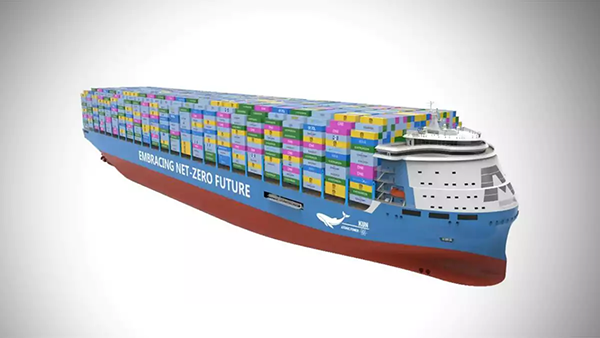
Thorium-Powered vs. Net-Zero Hopium: Unveiled at Marintec, December 2023, China’s state-owned Jiangnan Shipyard has credibly signalled how the world’s 200 million teu containerTEU: Twenty-foot Equivalent Unit trips a year could be accomplished—24 000 at a time, by the likes of the thorium-powered kun-24ap depicted here—fossil-fuel free and considerably faster.
rendering Jiangnan Shipyard
Mega-Oppenheimer An epic biographical thriller, followed by an epically swashbuckling docudrama series, is surely the surest route to convincing voters at large to demand and participate in the real-world megamobilisation. The production would need to rival Hollywood East in scale and quality, and would need to be as accurate as a non-Navajo Nation-denying Oppenheimer . New Zealand’s initial job would be to produce the book and movie versions of the modello, and mega-modello—beginning, perhaps, with a mini-Mahurangi proto-modello. The Climate Polycrisis is not a crisis that can be magicked away, even by covering 5.1 billiontotal surface area of Planet Earth, including ocean, in hectares hectares with photovoltaics, and their attendant batteries. The epochal mission is to mitigate the suffering of billions.
Return to footnote list
Rotary-valve 5-stroke modular generator Conceivably, the rotary-valve of Jim Clark–Bruce McLaren-impressing New Zealand engineer Ralph Watson could be married to Gerhard Schmitz’s astringently fuel-efficient 5-stroke to form the double-compound-v 3 heart of the ch2o2specifically, formic acid liquid-fueled small modular engine-generators required at-scale to zero-carbon-power everything from interisland ferries and intercity buses, to bulldozers. Regardless of their precise pedigree or configuration, such generators are needed in numbers commensurate with the Anthropocene biosphere’s current burden of one billionpredominantly private, 1.31 billion in 2020 light vehicle fleet, projected to be 2.21 billion by 2050 – International Energy Outlook 2021 private light vehicles—unless the profoundly inspired inside-out Wankel of Soviet-trainedDr Nikolai Shkolnik considers he was advantaged by his broader-than-American engineering training Dr Nikolai Shkolnik and his mit-trained son Dr Alec Shkolnik is indeed so superiorly thermally efficient—and can be made sufficiently clean-burning and reliable—that it does succeed in burying all new forms of the reciprocating piston engine, after its 312-year-and-counting reign. Mahurangi Magazine ’s money, meantime, is on the Schmitz–Watson modular generator, possibly sized to power a householdor modest private light vehicle—essential in the deeply unfortunate localities where reliable grid-electricity is no longer, was never, or is never likely to be, available.
Return to footnote list

Liquid Fuel from co2 Breakthrough: Although not the first to produce liquid fuel from carbon dioxide, Dr Ziyun Wang, right, in collaboration with researchers at Chinese institutions has developed a cost-effective alternative, particularly applicable—presumably—to powering those public transport modes that can’t practicably be grid-powered—intercity buses and interisland ferries spring to mind. Least said, meantime, of the far from affordable, sky-high cost of hydrogen-fuel-cell mobility. image University of Auckland
Six-degree narrow-bank v 9 fossil-free-petrol-head fantasy A 6° v might not sound like any sort of v-cylinder engine at all, but a bank-angle of 6° might be as much as makes sense, given anything more would put the cylinder heads in the bank of big low-pressure pots too far away from those of their counterparts in the high-pressure bank to be efficient, much less be serviced by a single, rotary-valve valve-train. The almost-inline v 9’s infinitely harmonisable exhaust acoustics, however, might more than make up for its less-than-Detriot-90° v machismo.
Return to footnote list
Megamobilisation vs. mega-mobilisation Setting aside whether it is wise to attempt to appropriate maga, or otherwise dignify it by imitation, the megamobilisation espoused in this article is the antithesis of the mega—Mobilizing an Earth Governance Alliance—approach, which relies upon firstly strengthening global governance architecture. As worthy as such a mission might be, it is directly analogous to waiting for fusion power before radically reducing fossil-fuel burning, with the likes of smr-generated power—on land and sea—pumped hydro storage, in-motion-charging trolleybuses, to mention but a few essential elements of a megamobilisation. The strengthening-global-governance goal—much less democratising global governance—having seen no progress in 77 years, now needs to be a byproduct of megamobilisation, not the prerequisite for it.
Return to footnote list
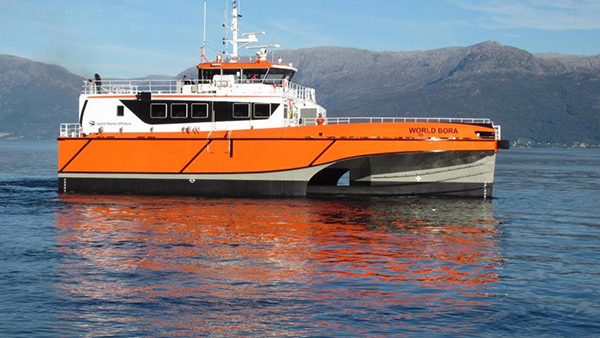
Mega-swash-Buckling Potential: Already deployed for a decade tending off-shore wind turbines, such small-waterplane-area-central-hulled vessels—built maybe 5 times longer than this 30-metre workboat—point the way to crossing stormy straits and seas, at speed and at scale, whilst insulating passengers from the terminally nauseating, kill-me-now affliction of mal de mer. Much kindlier passages, for example, than those provided the corner-to-corner-lurching high-speed twin-hull ferries, not to mention notoriously nausea-inducing high-speed tilting trains.
rendering Fjellstrand
Megamobilisation powerhouse The key to a small country pulling off the civilisation-and-the-biosphere-saving mission of instigating the Climate Polycrisis-megamobilisation, unavoidably, is monetisation. The ideal world in which the trillions needed to fund the megamobilisation would be allocated with the alacrity the world’s bankers were bailed out in 2008, doesn’t, of course, exist—how humanity is not seen as too big to fail and accorded the same largesse as banks, is a job for the anthropologists to explain. Meantime, in the interests of pursuing, hell-bent, the avenue that is available to Aotearoa is to manufacture and deliver the products and services the world desperately needs, playing to New Zealand’s strengths. The goods and services desperately needed range from proven, plural-rollIn 1867 in Aotearoa, Māori men were granted universal suffrage, 12 years before the European men there. electoral systems, to high-cube-40-foot-shipping-container-sized accommodation modules, at scale—the latter being just one of the ways planted-forest engineered timber can both sequester carbon long term, and displace carbon-culprits steel, aluminium, and cement. Logs, meantime, exported for use as concrete shuttering, are destined to soon return their hard-won carbon back to the atmosphere.
By becoming a world leader in the field, Aotearoa has a golden opportunity to monetise the transformation of its carbon Achilles heel, agriculture. In that multifaceted challenge, milk powder is analogous to the export of radiata pine logs, and the continued burning coal to dry milk is instructive regarding the fantasy of using less, renewable, energy, as opposed to generating a great deal
more energy, zero-carbon. Hansen, Sato, and Kharecha:
By 2030, there should be multiple options for modern ultrasafe nuclear power that can serve as the needed complement to renewable energies to produce carbon-free electricity.

Rolls-Royce of smrs: From its robust $16 billion-revenue base, the Rolls-Royce Group is likely to be one of the first to market with an attractive small modular reactor—poised to be in Poland, thanks to the slow-turning bureaucratic wheels in the United Kingdom. Rolls-Royce is no newcomer to building small reactors, having powered the Royal Navy’s nuclear submarines since 1966.
rendering Rolls-Royce
As the climate-tipping-point dominos fall, nuclear-free Aotearoa continues to behave unrepentantly hypocritically. Ideology has been allowed to trump science; twice: In the 1980s, opposition to nuclear-armed-United States-warship visits to New Zealand morphed into anti-nuclear-anything zealotry. In the 2010s, zero-carbon/sustainable energy sources were marketed as renewables, deliberately and disingenuously relegating zero-carbon nuclear power. Ever since, there has been a stubborn refusal to objectively accept that the rapid growth of renewables has neither displaced fossil fuels at scale nor provided the electricity and heat needed to produce, zero-carbon, the aluminium, ammonia, cement, hydrogen, plastics, steel, and the many other materials currently essential to civilisation.
Renewable–sustainable ideology is jeopardising the prospects of civilisation surviving the immediate climate-heating onslaught. Had the renewable, or sustainable, criteria been arbitrary imposed on those leaders who opposed Hitler, the Third Reich would never have been successfully resisted. There was nothing renewable about how the Allies defended democracy. World War II didn’t need to be sustainable, but for democracy to stand a chance it did have to be fought—even if democracy sometimes took a back seatnot in the sense, of course, of a staff-car back seat. Climate, meantime, has killed four million since 2000 but threatens the survival of billions in the coming decades. The twin overriding criteria for energy decisions must be their contribution to the rapid reduction in global greenhouse emissions and to the protection of proximately vulnerable populations.
Aotearoa, by delivering an anti-nuclear-power mea culpa now, committing to repurposing Huntly Power Station for fossil-fuel-free operation and to installing the planet’s first Rolls-Royce smr, would kickstart the country’s destiny on the world stage as the instigator of the Climate Polycrisis-megamobilisation.

Father of Democracy-Worst-Form-of-Government Bon Mot: French-Scottish Dunedin-New Zealand-trained First World War doctor, social anthropologist, and novelist Robert Briffault wrote the pithy critique and defence of democracy that was the meat of Churchill’s razor-sharp oratory, “…it has been said that democracy is the worst form of government, except for all others which have been tried…” Briffault died in 1948, the year after he was so memorably quoted.
image Pinterest
Return to footnote list
Democratic megamobilisation Given the prevailing democratic dysfunction, insisting that the Climate Polycrisis-megamobilisation be waged democratically will seem to many—possibly to most —as less than optimal. Setting aside the serially-misattributed—
Democracy is the worst form of government.
—if the megamobilisation is to happen, it will be because the people demand it, channelled by compelling, charismaticas opposed to populist, Churchillian leader ship. Churchill’s verbatim use of the bald seven-word sentence was directly from the writing of initially New Zealand-educated, social anthropologist Robert Briffault (1930) :
Democracy is the worst form of government. It is the most inefficient, the most clumsy, the most unpractical. No machinery has yet been contrived to carry out in any but the most farcical manner its principles. It reduces wisdom to impotence and secures the triumph of folly, ignorance, clap-trap and demagogy. But there is something even more important than efficiency and expediency—justice. And democracy is the only social order that is admissible, because it is the only one consistent with justice.
Churchill, in his 1947 Parliamentary address, didn’t imply authorship—he deliberately prefaced the dictum with, “while it is said”. He then proceeded to do justice to its source—Briffault’s unbridled critique of democracy and adamant defence of it as the only form of government compatible with justice—by following his deft except-for-all-others-which-have-been-tried paraphrasinpossibly also descriptions of other forms of government also contained in Rational Evolution: The Making of Humanity, 1930g with:
…there is the broad feeling in our country that the people should rule, continuously rule, and that public opinion, expressed by all constitutional means, should shape, guide, and control the actions of Ministers who are their servants and not their masters.
Setting aside the inconvenient, undemocratic, pro-House of Lords-intent behind Churchill’s 11 November 1947 speech, the Mahurangi Magazine contends that the answer to Briffault’s entirely-valid-in-1930 contention, the ingenious machinery has long since been contrived to carry out, in the most elegantand most transparent manner, all the important principles of democracy—including the long-overdue, less-than-skin-deep democratisation of the political-party system. Only the self-interest of political parties and their corporate overlords, stands in the way.
Return to footnote list
Return to article
Disclosure The author of this article is the secretary of both Mahurangi Action Incorporated and the Mahurangi Coastal Path Trust, and has voted Māori, more than once—although the particularly stringent strategic-voting demanded, in 2023, that Green be supported, heavily outweighed any lesser-of-two-neoliberal-evils usefulness of voting for that which masqueraded as Red. The article published here, meantime, is that of the editorially independent, independently funded Mahurangi Magazine.
 1 2 3 fix mmp
About, about…
Annual report
chart competition
Climate-action mobilisation
hmss Buffalo
Jade River: A History of the Mahurangi
Mahurangi Action Inc.
Mahurangi Action Plan
Mahurangi Coastal Path
Mahurangi Gallery
Mahurangi Magazine
Mahurangi Regatta
Open-ground indigenous plants establishment trials
Regional parkland
Watermills, millraces, dams and weirs
1 2 3 fix mmp
About, about…
Annual report
chart competition
Climate-action mobilisation
hmss Buffalo
Jade River: A History of the Mahurangi
Mahurangi Action Inc.
Mahurangi Action Plan
Mahurangi Coastal Path
Mahurangi Gallery
Mahurangi Magazine
Mahurangi Regatta
Open-ground indigenous plants establishment trials
Regional parkland
Watermills, millraces, dams and weirs
















